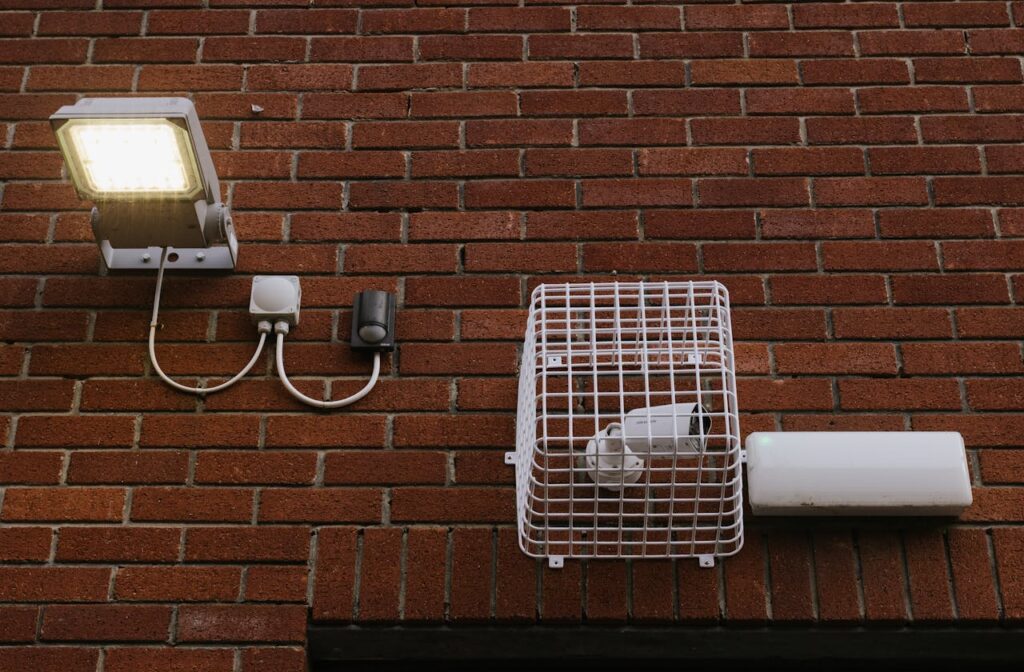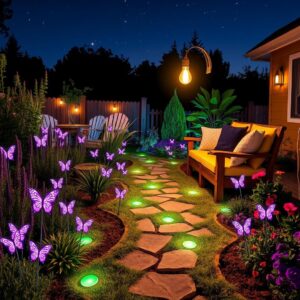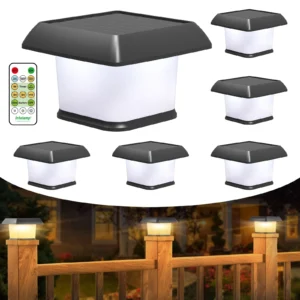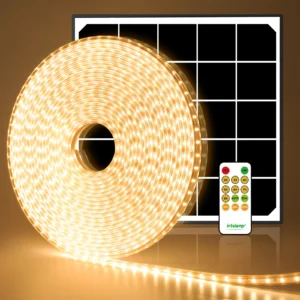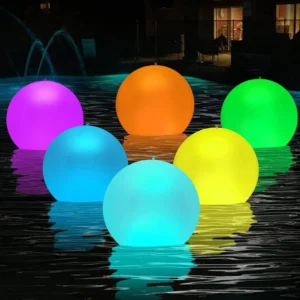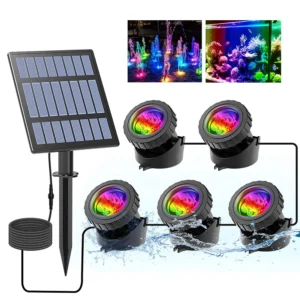Are you tired of constantly replacing your outdoor lights due to their short lifespan and high energy consumption? It’s time to switch to a smarter and more sustainable solution—solar PIR lights! These innovative lights not only save you money on electricity bills but also help reduce your carbon footprint.
In this article, we’ll delve into the world of solar PIR lights and explore their benefits, functionality, and why they’re worth every penny.
1. What is PIR in Solar Lights?
PIR, or Passive Infrared, is a technology widely used in solar lights to detect movement based on changes in infrared radiation. These sensors work by sensing the heat emitted by objects, including humans and animals, within their detection range. Here’s a more detailed look at how PIR sensors function and their role in solar lighting systems:
How PIR Sensors Work
PIR sensors are designed to detect infrared radiation, which is emitted by all warm bodies. They consist of two main components: a sensor and a lens. The sensor detects changes in heat levels, while the lens helps focus and broaden the detection area.
Heat Detection: When an object, such as a person or animal, moves within the sensor’s range, it causes a change in infrared radiation levels. The sensor detects this change and sends a signal to activate the light.
Field of View: Most PIR sensors have a specific field of view, typically between 90 and 180 degrees. This means they can cover a substantial area for detecting movement, making them ideal for outdoor lighting applications.
Dual-Element Sensors: Many PIR sensors use a dual-element design, which allows them to detect differences in infrared radiation across two areas. This setup reduces false alarms by ensuring that the detected changes occur in rapid succession, confirming movement rather than random temperature fluctuations.
Advantages of PIR Sensors in Solar Lights
Energy Efficiency: One of the primary benefits of PIR sensors is their ability to conserve energy. Since the lights only activate when movement is detected, they use minimal power, which is particularly advantageous for solar-powered systems that rely on battery storage.
Cost-Effectiveness: PIR sensors are relatively inexpensive compared to other motion detection technologies. This cost-effectiveness makes them a popular choice among manufacturers of solar lights, ensuring that consumers can benefit from advanced technology without breaking the bank.
Low Power Consumption: PIR sensors require very little power to operate, which is ideal for solar applications. This efficiency means that even on cloudy days, when solar panels may generate less energy, the lights can still function effectively.
Improved Security: The ability to detect movement allows solar PIR lights to enhance security. They illuminate areas when someone approaches, deterring potential intruders and providing safety for residents and visitors.
Limitations of PIR Sensors
While PIR sensors offer numerous advantages, they also have some limitations:
Temperature Sensitivity: PIR sensors may not detect objects that do not emit significant heat, such as small animals or cold metal objects. This can result in missed detections in certain situations.
Environmental Factors: External factors like wind, rain, and temperature fluctuations can impact the sensor’s performance. For instance, rapid temperature changes can trigger false alarms.
Limited Range: The detection range of PIR sensors can be limited. Most models have a maximum range of 20 to 40 feet, depending on the design and sensitivity settings.
2. How Do Solar PIR Lights Work?
Solar PIR lights are designed to provide efficient outdoor illumination by harnessing solar energy and utilizing motion detection technology. Here’s an overview of their operation, focusing on energy collection and activation processes:
1. Energy Collection
The operation of solar PIR lights begins with energy collection through solar panels. These panels convert sunlight into electrical energy, which is stored in a rechargeable battery for later use. Here’s how this process works:
Solar Panel Functionality: Solar panels are typically made of photovoltaic cells that absorb sunlight and convert it into direct current (DC) electricity. This conversion is most efficient during clear, sunny days, allowing the panels to generate sufficient power.
Battery Storage: The generated electricity is directed into a rechargeable battery, which stores the energy for use when sunlight is not available—typically at night or during overcast conditions. The capacity of the battery is crucial, as it determines how long the lights can operate before needing a recharge.
Charging Cycle: Solar PIR lights often come with a built-in charge controller to regulate the flow of electricity between the solar panel and the battery. This controller prevents overcharging and helps maintain the battery’s health, ensuring long-term reliability.
2. Activation Process
Once the solar PIR lights have collected and stored energy, the next step is the activation process, which is triggered by the motion detected by the PIR sensor. Here’s a detailed look at this activation mechanism:
Dusk to Dawn Operation: As daylight fades, a light sensor within the system detects the reduction in ambient light levels. This transition signals the system to prepare for potential activation. The lights remain off during the day to conserve battery power.
Motion Detection: When a person or object moves within the sensor’s range, the PIR sensor detects changes in infrared radiation levels. The sensor is calibrated to respond to specific temperature variations, confirming the presence of a warm body.
Light Activation: Upon detecting motion, the PIR sensor sends a signal to the lighting system, prompting it to turn on. The battery then supplies power to the LED light, illuminating the area effectively.
Duration of Illumination: Most solar PIR lights have a predefined duration for how long they remain lit after detecting motion, which can typically range from 10 seconds to several minutes, depending on the model and settings. This feature ensures that the lights conserve energy by turning off after a set period of inactivity.
Automatic Shut-Off: After the set duration or when no further movement is detected, the lights automatically turn off. This energy-saving feature helps prolong battery life and reduces the need for frequent recharging.
Additional Features
Many solar PIR lights come with adjustable settings that allow users to customize the sensitivity of the motion sensor, the duration of illumination, and the light’s brightness. These features enhance usability and adaptability to various environments, making them suitable for different applications, from home security to outdoor gatherings.
3. Are Solar PIR Lights Any Good?
Solar PIR lights have gained popularity as an eco-friendly and cost-effective solution for outdoor lighting. However, like any product, they come with their advantages and disadvantages. Here’s an in-depth look at the pros and cons, including efficiency and performance factors:
Pros of Solar PIR Lights
Energy Efficiency:
Solar PIR lights harness renewable energy from the sun, significantly reducing electricity costs. They rely on solar panels to charge a battery, allowing for continuous operation without increasing your energy bills.Environmental Benefits:
By using solar energy, these lights contribute to a reduction in carbon footprint. They do not emit greenhouse gases during operation, making them an eco-friendly choice for outdoor lighting.Easy Installation:
Solar PIR lights are typically easy to install since they do not require wiring or electrical connections. Most models come with mounting hardware, enabling quick setup in various outdoor locations.Enhanced Security:
The motion detection feature of PIR lights adds an extra layer of security to your property. By illuminating areas when movement is detected, they deter potential intruders and provide visibility in dark spaces.Low Maintenance:
Solar PIR lights generally require minimal maintenance. Regular cleaning of the solar panels and occasional battery checks are usually sufficient to keep the lights functioning optimally.Durability:
Many solar PIR lights are designed for outdoor use, featuring weather-resistant materials that can withstand rain, snow, and UV exposure. This durability extends their lifespan compared to traditional outdoor lights.
Cons of Solar PIR Lights
Dependence on Sunlight:
The performance of solar PIR lights heavily relies on sunlight exposure. In regions with prolonged cloudy weather or limited daylight, the efficiency and illumination duration may be compromised.Battery Limitations:
The lifespan and performance of solar PIR lights are influenced by the quality of the battery. Over time, batteries can degrade, leading to shorter operational times and diminished brightness.Variable Brightness:
The brightness of solar PIR lights can vary based on several factors, including the quality of the solar panel, the amount of sunlight received, and the efficiency of the LED used. This variability may affect the light’s effectiveness in illuminating larger areas.Sensitivity Issues:
PIR sensors can sometimes be overly sensitive, triggering the light due to non-human movements like animals or environmental changes (e.g., wind-blown branches). Conversely, they may not detect smaller, cooler objects, leading to missed activations.Limited Range:
Most PIR sensors have a specific detection range, usually between 20 to 40 feet. Depending on the installation location, this limited range may not cover larger areas effectively, resulting in dark spots.Initial Cost:
While solar PIR lights save money in the long run, their initial purchase price can be higher than traditional outdoor lighting options. However, this cost is often offset by savings on electricity bills over time.
Performance Factors
Quality of Components:
The efficiency and performance of solar PIR lights are heavily influenced by the quality of the solar panel, battery, and LED bulbs used. Higher-quality components typically result in better energy generation, storage, and illumination.Installation Location:
The placement of the lights is crucial for optimal performance. Installing solar PIR lights in areas that receive direct sunlight for most of the day enhances their charging capability and ensures they function effectively during the night.Seasonal Variability:
Performance can vary with the seasons. During winter months, shorter daylight hours can lead to reduced battery charging, impacting how well the lights operate during darker nights.User Settings:
Many solar PIR lights come with adjustable settings for sensitivity and duration. Users can tailor these settings to their specific needs, optimizing performance based on their environment and usage patterns.
4. What is the Disadvantage of PIR Sensors?
While PIR (Passive Infrared) sensors are widely used in solar lights for their efficiency and effectiveness in motion detection, they do have certain limitations and potential drawbacks. Understanding these disadvantages is crucial for evaluating their suitability for specific applications.
1. Sensitivity to Temperature Changes
PIR sensors detect motion by measuring changes in infrared radiation emitted by objects, primarily warm bodies like humans and animals. However, this sensitivity can lead to limitations:
False Alarms: PIR sensors may trigger an alarm or activate lights due to temperature changes caused by other factors, such as moving vehicles, heating vents, or even the ambient temperature fluctuations in the environment. This can result in unnecessary illumination, which can be frustrating for users.
Non-Human Detection: Objects that do not emit significant heat, such as rocks or cold metal objects, will not activate the sensor. This means that the system might fail to detect the presence of intruders if they are not generating enough infrared radiation.
2. Limited Detection Range
PIR sensors have a specified detection range, typically between 20 to 40 feet, depending on the model. This limitation can pose challenges:
Blind Spots: Areas outside the sensor’s detection range remain unmonitored, which can create vulnerabilities, especially in security applications. Depending on the placement and angle of the sensor, blind spots may compromise the effectiveness of the lighting or security system.
Field of View: The detection field of PIR sensors is usually cone-shaped, which means they are more effective at detecting motion coming directly towards them. If a person approaches from the side or at an angle, they may go undetected.
3. Environmental Influences
PIR sensors can be affected by various environmental conditions, leading to decreased performance:
Temperature Extremes: Extremely high or low temperatures can affect the sensor’s accuracy. For instance, in very hot climates, the sensor might have difficulty distinguishing between background heat and a person’s body heat.
Weather Conditions: Rain, snow, or heavy winds can also impact the performance of PIR sensors. For example, wind-blown vegetation may cause false activations, while heavy snowfall could obscure the sensor’s view.
4. Installation Considerations
The effectiveness of PIR sensors largely depends on their installation:
Improper Placement: If a PIR sensor is installed too high, too low, or facing the wrong direction, it may not function optimally. Ensuring correct placement is critical to maximize detection capabilities.
Obstructions: Physical obstructions, such as walls, trees, or fences, can block the sensor’s field of view, reducing its effectiveness. Proper site assessment is necessary before installation.
5. Power Consumption
While PIR sensors are designed to be energy-efficient, they still require a small amount of power to operate:
- Battery Drain: Continuous false activations due to environmental factors can lead to increased battery drain, affecting the overall performance and lifespan of solar PIR lights. Inadequate battery capacity may further exacerbate this issue.
6. Cost and Complexity
Although PIR sensors are generally affordable, some advanced models with enhanced features may come with a higher price tag:
- Cost vs. Benefit: For users seeking a simple solution, the added cost of more sophisticated PIR sensors may not justify the benefits. Understanding the specific needs and potential trade-offs is essential for making an informed purchase decision.
5. Why Do Most Solar Lights Use PIR Instead of Microwave Sensors?
When it comes to motion detection in solar lights, PIR (Passive Infrared) sensors are the predominant choice over microwave sensors. This preference stems from several key differences in functionality, cost, power consumption, and reliability. Here’s a detailed comparison between the two technologies, highlighting why PIR sensors are favored in solar lighting applications.
1. Detection Mechanism
PIR Sensors:
PIR sensors operate by detecting infrared radiation emitted by objects. They sense changes in heat within their field of view, making them highly effective for detecting human and animal movement. When a warm body enters the detection zone, the sensor triggers the light.Microwave Sensors:
Microwave sensors use electromagnetic waves to detect motion. They emit microwave signals and measure the reflection of these signals off moving objects. This allows them to detect motion regardless of temperature, making them capable of detecting non-thermal objects as well.
2. Power Consumption
PIR Sensors:
PIR sensors are known for their low power consumption. They typically require very little energy to operate, which is ideal for solar-powered devices that rely on limited energy storage. This efficiency extends the lifespan of the batteries used in solar lights.Microwave Sensors:
Microwave sensors generally consume more power than PIR sensors due to their active signaling nature. They continuously emit microwaves, which can lead to quicker battery depletion in solar-powered systems, reducing their operational efficiency.
3. Cost Considerations
Affordability of PIR Sensors:
PIR sensors are typically more cost-effective to manufacture and purchase than microwave sensors. Their simplicity in design and low component costs make them accessible for both manufacturers and consumers, which contributes to their widespread use in budget-friendly solar lighting options.Higher Cost of Microwave Sensors:
Microwave sensors tend to be more expensive due to their advanced technology and the additional components required for their operation. This higher cost may deter users looking for economical solutions for outdoor lighting.
4. Reliability and Performance
Effectiveness in Various Conditions:
PIR sensors are particularly reliable in detecting motion caused by warm bodies, making them suitable for applications focused on human and animal movement. Their effectiveness is less likely to be impacted by environmental factors like temperature variations.Susceptibility to Interference:
Microwave sensors can be affected by external electromagnetic interference, such as signals from other devices or environmental factors like rain and wind. This interference can lead to false triggers or missed detections, impacting their reliability in outdoor settings.
5. Installation Flexibility
Ease of Installation:
PIR sensors are generally easier to install, as they do not require complex wiring or calibration. This makes them a popular choice for DIY installations, where users can quickly set up their solar lights without specialized knowledge.Positioning Considerations:
While both types of sensors require careful positioning, microwave sensors may need to be installed at specific angles to ensure optimal detection. This can complicate the installation process and require more planning.
6. Detection Range and Coverage
Range Limitations of PIR Sensors:
PIR sensors have a defined detection range (usually 20 to 40 feet) and a limited field of view, which can result in blind spots. However, they are specifically designed to cover areas where human movement is expected, making them effective for many outdoor applications.Broader Detection of Microwave Sensors:
Microwave sensors have a longer detection range and can cover a larger area due to their broader field of view. However, this advantage can lead to increased false alarms, as they may trigger for objects outside the intended detection zone.
7. Environmental Impact
Eco-Friendliness of PIR Sensors:
By relying on solar power and consuming minimal energy, PIR sensors align well with eco-friendly practices. They contribute to sustainable lighting solutions without the added energy demand associated with microwave sensors.Energy Use Concerns with Microwave Sensors:
The higher energy consumption of microwave sensors can negate some of the benefits of using solar energy, potentially leading to a larger carbon footprint over time.
6. Can PIR Be Used Outside?
PIR (Passive Infrared) sensors are widely utilized in outdoor lighting applications due to their effectiveness in detecting motion and their compatibility with solar-powered systems. However, for successful outdoor use, several factors must be considered, including suitability, weatherproofing, and installation practices. Here’s an in-depth look at the aspects that determine whether PIR sensors can function effectively in outdoor environments.
1. Design and Construction
Weather Resistance:
Many PIR sensors are designed specifically for outdoor use and come with weather-resistant features. This includes enclosures made from durable materials that can withstand harsh environmental conditions such as rain, snow, and UV rays from sunlight. When choosing a PIR sensor for outdoor applications, it’s crucial to look for models labeled as “weatherproof” or “outdoor rated.”Protection Against Elements:
Effective outdoor PIR sensors often have seals and gaskets that prevent moisture and dust ingress, which can compromise the sensor’s functionality. Additionally, they may feature coatings that protect against corrosion and UV damage, ensuring longevity and reliable performance.
2. Temperature Tolerance
Performance in Extremes:
PIR sensors are designed to operate within a specific temperature range. While most sensors function well in moderate climates, extreme temperatures—whether hot or cold—can affect their accuracy. High temperatures may lead to false activations, while extremely low temperatures can impair performance. It’s essential to select PIR sensors rated for the expected temperature ranges of your specific outdoor environment.Adaptive Features:
Some advanced PIR sensors come with built-in features that adjust sensitivity based on temperature changes. This adaptability can enhance their effectiveness in fluctuating weather conditions.
3. Mounting and Positioning
Optimal Placement:
The placement of PIR sensors is critical for their effectiveness outdoors. They should be mounted at an appropriate height and angle to maximize their detection capabilities while minimizing potential obstructions. Additionally, sensors should be positioned away from direct exposure to heavy rain or snow accumulation, which could affect their operation.Avoiding Obstructions:
Trees, walls, and other structures can obstruct the field of view, resulting in blind spots. Proper site assessment is necessary to ensure that the sensor can detect movement effectively without interference from surrounding objects.
4. Sensitivity to Environmental Factors
Influence of Wind and Vegetation:
Outdoor environments often have variable conditions, such as wind-blown foliage and fluctuating temperatures. PIR sensors may trigger false alarms due to these factors, especially if they are too sensitive. Adjusting the sensitivity settings can help mitigate this issue, allowing for more reliable performance.Lighting Conditions:
Although PIR sensors function primarily based on infrared detection, extreme lighting conditions can impact their operation. Bright lights or reflective surfaces in the vicinity may confuse the sensor, leading to unintended activations. Proper positioning can help avoid these pitfalls.
5. Durability and Maintenance
Long-Term Use:
Outdoor PIR sensors are built to withstand exposure to various elements, but regular maintenance can extend their lifespan. Cleaning the sensor lens to remove dirt, snow, or debris will ensure optimal performance. Additionally, inspecting the housing for any signs of wear or damage will help maintain their weatherproof capabilities.Battery Considerations:
For solar-powered PIR lights, ensuring that the solar panel is clean and unobstructed is vital for charging efficiency. Keeping the sensor and solar panel clear of obstructions will maximize energy collection and enhance the overall effectiveness of the system.
6. Applications and Versatility
Wide Range of Uses:
PIR sensors are commonly used in various outdoor applications, such as security lighting, garden lights, and pathway illumination. Their motion detection capabilities make them particularly effective for enhancing security by illuminating areas when movement is detected.Integration with Other Technologies:
Many outdoor PIR systems can be integrated with additional technologies, such as cameras or alarms, providing a comprehensive security solution. This versatility makes them suitable for both residential and commercial applications.
7. Do Solar PIR Lights Need Direct Sunlight?
Solar PIR lights harness energy from the sun to function effectively, but their performance can vary based on the amount and quality of sunlight they receive. Understanding the sunlight requirements for these lights is crucial to ensure optimal performance and longevity. Here’s an in-depth exploration of how sunlight impacts solar PIR lights.
1. Energy Collection
Solar Panel Functionality:
Solar PIR lights are equipped with solar panels that convert sunlight into electrical energy. These panels rely on direct sunlight to generate sufficient power for the light’s operation. The efficiency of solar panels generally increases with exposure to direct sunlight, allowing them to charge the battery effectively.Shaded Conditions:
While some solar lights can function with limited sunlight exposure, such as on cloudy days, their performance is significantly diminished in shaded or low-light conditions. If a solar panel receives only a few hours of indirect sunlight, it may not collect enough energy to power the light through the night.
2. Sunlight Requirements
Optimal Conditions:
For maximum efficiency, most solar PIR lights should be placed in areas that receive direct sunlight for a significant portion of the day, ideally around six to eight hours. This exposure allows the solar panel to fully charge the battery, ensuring the light can operate effectively when motion is detected.Variability Among Models:
Different models of solar PIR lights come with varying requirements for sunlight exposure. Higher-quality models often feature larger solar panels that can generate more energy even with limited sunlight, making them suitable for partially shaded areas. It’s essential to check the manufacturer’s specifications for sunlight requirements to select the best option for your environment.
3. Battery Capacity and Performance
Battery Storage:
The amount of sunlight a solar PIR light receives directly affects its battery capacity. A well-charged battery can typically power the light for several hours, depending on its usage patterns and the duration of motion detection. Insufficient sunlight leads to inadequate battery charging, which can result in dim lighting or reduced operational hours.Type of Battery:
The type of battery used in solar PIR lights also plays a role in performance. Lithium-ion batteries, for example, tend to have higher energy density and better longevity than older nickel-cadmium batteries. Selecting a model with a high-quality battery can improve overall performance, even with varying sunlight conditions.
4. Seasonal Considerations
Impact of Seasons:
Seasonal changes can significantly affect sunlight availability. During winter months, shorter days and lower sun angles can reduce the amount of solar energy collected. It’s important to consider this when installing solar PIR lights, as their performance may decline during colder months.Adapting to Conditions:
Some advanced solar PIR lights come with built-in features to adapt to seasonal variations. For instance, they may have energy-saving modes that optimize performance based on battery levels, allowing them to last longer during periods of reduced sunlight.
5. Placement Tips
Choosing the Right Location:
To maximize sunlight exposure, install solar PIR lights in areas that are free from obstructions such as trees, buildings, or fences. South-facing locations often receive the most sunlight throughout the day in the northern hemisphere, making them ideal for solar panel efficiency.Angle of Installation:
The angle at which the solar panel is installed can also affect energy collection. Tilt the panel to capture maximum sunlight, particularly in regions where the sun’s path varies significantly across seasons.
6. Maintenance for Optimal Performance
Regular Cleaning:
Dust, debris, and snow can accumulate on solar panels, reducing their ability to collect sunlight. Regular cleaning of the solar panel surface ensures that it operates at peak efficiency. Use a soft cloth or sponge and mild detergent to avoid scratching the panel.Inspection for Damage:
Periodically inspect the solar panel and associated components for any signs of damage or wear. Ensuring that all parts are in good condition will contribute to the overall efficiency and longevity of the solar PIR lights.
8. Do Solar PIR Lights Work in Winter?
Solar PIR lights are designed to provide reliable outdoor illumination, but their performance can be influenced by seasonal changes, particularly during the winter months. Understanding how these lights operate in colder conditions is crucial for ensuring their effectiveness year-round. Here’s a comprehensive look at the factors affecting solar PIR lights during winter.
1. Reduced Sunlight Hours
Shorter Days:
Winter days are significantly shorter, leading to reduced sunlight exposure. This decrease in daylight hours can limit the amount of solar energy collected by the panels, impacting the overall charging capacity of the lights.Lower Sun Angle:
The sun’s angle during winter is lower in the sky, which can result in less direct sunlight hitting the solar panels. This reduced exposure can further decrease the efficiency of energy collection.
2. Cold Temperatures
Impact on Battery Performance:
Cold temperatures can affect the chemical reactions in batteries, particularly in lead-acid and nickel-cadmium batteries, potentially leading to reduced efficiency and shorter operational times. Lithium-ion batteries generally perform better in cold conditions, but their capacity can still diminish.Energy Storage Limitations:
As temperatures drop, the energy storage capacity of the battery may decrease, meaning that even if the lights collect some sunlight, they might not hold enough energy to operate effectively during the night.
3. Operational Reliability
Functionality in Low Light:
Many solar PIR lights are designed with built-in features that allow them to function even in lower light conditions. However, their performance may be compromised if the battery is not sufficiently charged due to limited sunlight.Motion Detection:
PIR sensors rely on detecting heat changes in their environment. In winter, the presence of snow or ice can sometimes obstruct the sensor’s ability to detect movement, which could affect the lights’ activation.
4. Model Specifications
Choosing the Right Model:
Some solar PIR lights are specifically designed for cold-weather performance, featuring enhanced batteries and more efficient solar panels. When selecting solar lights, look for models that indicate winter suitability or those with larger panels that can collect more energy.Built-in Features:
Advanced models may come with features like energy-saving modes or adjustable sensitivity settings, allowing them to conserve battery life and extend operational time even when conditions are less than ideal.
5. Installation Considerations
Placement for Optimal Sun Exposure:
To maximize performance during winter, install solar PIR lights in locations that receive the most sunlight throughout the day. Avoid placing them in areas where snow may accumulate or block the solar panels.Tilt and Angle:
Adjusting the angle of the solar panel to capture maximum sunlight during the winter months can significantly improve energy collection. Ensuring that the panels are oriented to face south (in the northern hemisphere) can help optimize performance.
6. Maintenance During Winter
Snow Removal:
Regularly check the solar panels for snow accumulation and clear any snow off the surface. This ensures that the panels can collect as much sunlight as possible.Cleaning and Inspection:
In addition to snow removal, it’s important to clean the solar panels from any debris, ice, or frost that may accumulate. Inspecting for any damage to the lights and ensuring they are functioning properly is also key to maintaining performance.
9. How Long Do Solar PIR Lights Last?
The lifespan of solar PIR lights is influenced by various factors, including usage patterns, environmental conditions, the quality of components, and maintenance practices. Understanding these factors can help you maximize the longevity of your solar lights and ensure they provide reliable service for years to come.
1. Quality of Components
Solar Panels:
High-quality solar panels are crucial for efficient energy collection and long-term durability. The best panels are typically made from monocrystalline silicon, which offers higher efficiency and better performance in low-light conditions. Cheaper panels may degrade faster, reducing their energy output over time.Batteries:
The type and quality of the battery used in solar PIR lights play a significant role in determining their lifespan. Lithium-ion batteries are generally more efficient and longer-lasting compared to traditional lead-acid or nickel-cadmium batteries. A high-quality battery can last anywhere from 3 to 5 years, while lower-quality options may need replacement within a year or two.LED Bulbs:
LED bulbs used in solar PIR lights can last a long time, typically ranging from 25,000 to 50,000 hours of use. However, the actual lifespan may vary depending on the quality of the LEDs and how often the light is activated.
2. Usage Patterns
Frequency of Use:
The more frequently a solar PIR light is activated, the quicker the battery will discharge. Regular use can reduce the battery’s overall lifespan, especially if the lights are triggered multiple times during the night. Balancing usage can help extend the life of the components.Light Duration:
Some solar PIR lights allow users to adjust how long the light remains on after being activated. Setting a shorter duration can help conserve battery life, especially during periods of low sunlight.
3. Environmental Conditions
Weather Exposure:
Constant exposure to harsh weather conditions—such as extreme heat, cold, rain, or snow—can negatively impact the lifespan of solar PIR lights. Weather-resistant models are designed to withstand these conditions better, so choosing the right product for your local climate is essential.Temperature Fluctuations:
Significant temperature changes can affect both the solar panels and the battery. For instance, extreme cold can reduce battery efficiency, while extreme heat can degrade the components more quickly.
4. Maintenance Practices
Regular Cleaning:
Keeping the solar panels clean and free of debris, dust, or snow is vital for optimal performance. Regular cleaning can ensure that the panels receive maximum sunlight, enhancing energy collection and extending the lifespan of the lights.Inspecting for Damage:
Periodically check for any signs of wear or damage, including cracks in the solar panel or housing, loose connections, or water ingress. Addressing issues promptly can prevent further damage and prolong the life of the lights.Battery Care:
If your solar PIR light allows for battery replacement, choose high-quality batteries that are compatible with your device. Monitor battery performance and replace them as needed to maintain functionality.
5. Average Lifespan
Typical Lifespan:
On average, well-made solar PIR lights can last anywhere from 5 to 10 years with proper care. However, some premium models with high-quality components can last even longer. Factors such as usage patterns and environmental conditions will ultimately determine how long they will function effectively.Signs of Wear:
Be on the lookout for signs that your solar PIR light is nearing the end of its lifespan, such as dimming light output, reduced activation frequency, or failure to charge properly. If you notice these issues, it may be time to consider a replacement.
Conclusion
In summary, solar PIR lights are a cost-effective and eco-friendly solution for outdoor lighting needs. They harness solar power to provide reliable, energy-efficient lighting with added motion detection capabilities for enhanced security. Ideal for both residential and commercial settings, these lights are a smart choice for anyone looking to reduce their carbon footprint and save on energy costs. With ongoing advancements in technology, the design and functionality of solar PIR lights continue to improve, making them a popular option for illuminating outdoor spaces.

